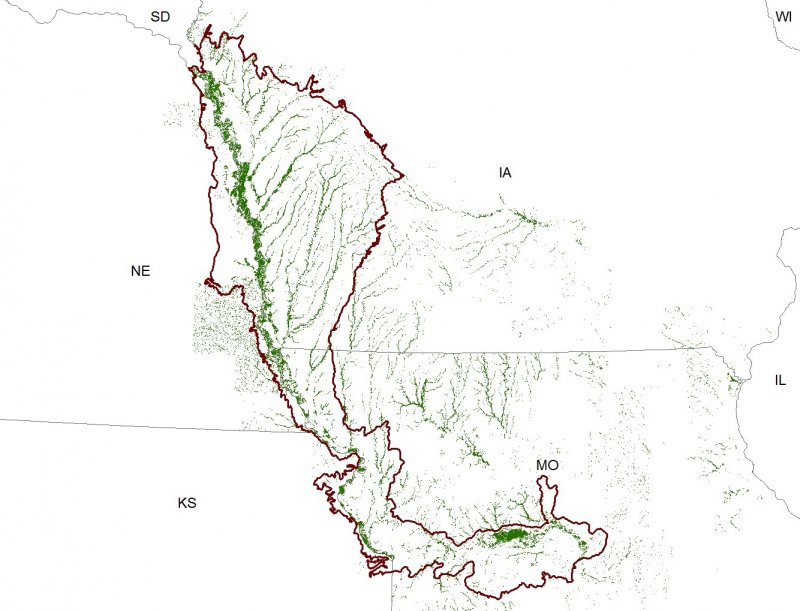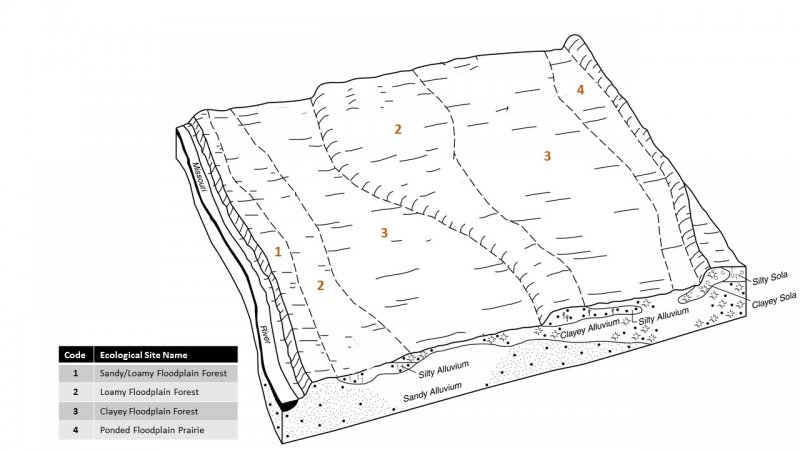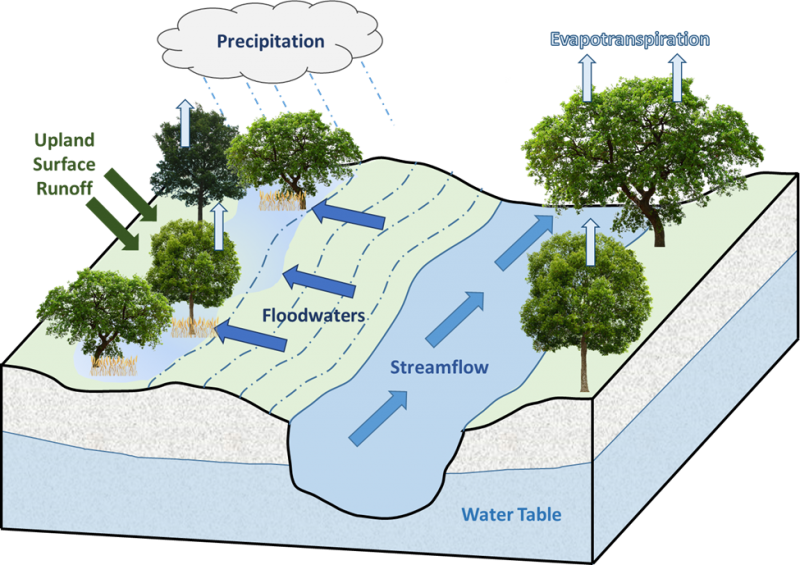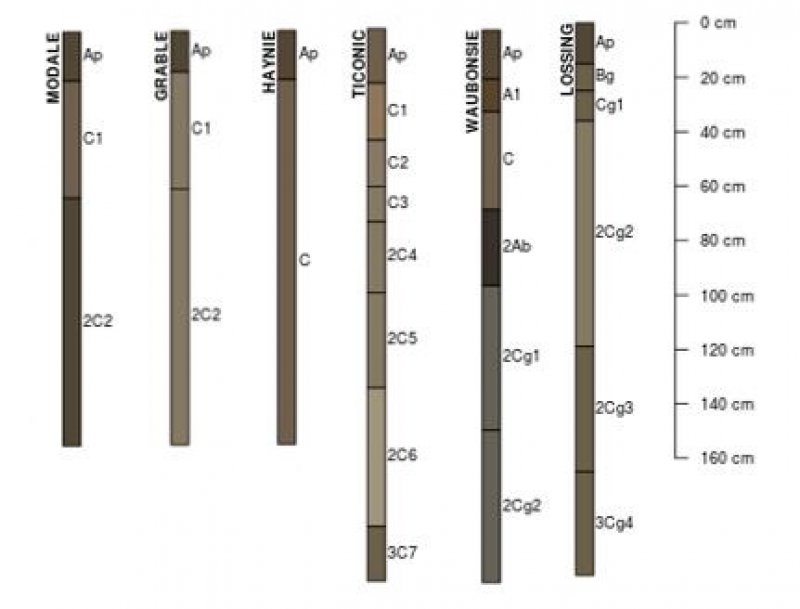Ecological dynamics
The Loess Hills region lies within the transition zone between the eastern deciduous forests and the Great Plains, with the Missouri River flowing through the middle. The heterogeneous topography of the area results in variable microclimates and fuel matrices that in turn are able to support prairies, savannas, woodlands, and forests (Nelson 2010). Loamy Floodplain Forests form an aspect of this vegetative continuum. This ecological site occurs on floodplains near the stream channel on silty alluvial soils. Species characteristic of this ecological site consist of hydrophytic woody and herbaceous species.
Flooding is the dominant disturbance factor in Loamy Floodplain Forests. Within MLRA 107B, seasonal flooding and/or saturation occurs in the fall, winter, and spring on average every two to five years. The water table is high, and shallow flooding can persist for over a month, particularly in the early growing season. Flooding lasts approximately twelve to twenty percent of the season (Nelson 2010).
Windthrow events, beaver activity, and periodic insect and disease outbreaks influence this site to a lesser, more localized extent (LANDFIRE 2009; Nelson 2010). Windthrow events are mostly caused from tornadoes and associated winds and generally occur in the early summer months. Immediate responses to high wind events can alter forest structure and species richness or evenness, thereby impacting species diversity. Composition can also shift to one containing more early-successional species (Peterson 2000). Beaver disturbances can be highly variable across the MLRA and likely had little impact on stands less than ten years old (LANDFIRE 2009).
Today, many original Loamy Floodplain Forests have been reduced as a result of upland soil erosion and drainage and clearing for agriculture and urban development. Sites have also been degraded by stream channelization, levee construction, and overgrazing which alters the hydrologic flood cycles and, ultimately, the reference plant community. Invasive species, such as garlic mustard (Alliaria petiolata L.), multiflora rose (Rosa multiflora Thunb.), dames rocket (Hesperis matronalis L.), Siberian elm (Ulmus pumila L.) and Oriental bittersweet (Celastrus orbiculata Thunb.) have been invading this site and reducing native species diversity (Nelson 2010; Steinauer and Rolfsmeier 2010).
State 1
Reference State
The reference plant community is categorized as a closed canopy oak-cottonwood forest. The two community phases within the reference state are dependent on seasonal flood events. Long-term sediment accumulation can elevate the forest floor resulting in less flooding and a more stable plant community with an increasing number of upland species inhabiting the site. A catastrophic flood event removes younger, flood-intolerant species, resetting the site to an earlier stage of succession. Windthrow, beaver predation, and periodic insect and disease outbreak have less impact in the reference phases, but do contribute to overall species composition, diversity, cover, and productivity.
Community 1.1
Swamp White Oak – Eastern Cottonwood/Fowl Mannagrass – Bristly Buttercup
Swamp white oak and eastern cottonwood are the characteristic tree species for this reference community phase, with sub-dominants including bur oak, green ash, and slippery elm (Nelson 2010). Tree heights range between 90-140 feet tall, tree size class is very large (>33-inches DBH), and the canopy is closed (100 percent) (LANDFIRE 2009; Nelson 2010). Grape, eastern poison ivy, and numerous shade- and flood-tolerant sedges and forbs form a well-developed understory and often include fowl mannagrass, various sedges, bristly buttercup (Ranunculus hispidus Michx.), wingstem (Verbesina alternifolia (L.) Britton ex Kearney), and smallspike false nettle (Boehmeria cylindrica (L.) Sw.) (Nelson 2010).
Community 1.2
Bur Oak – Shellbark Hickory / Green Ash / Virginia Wild Rye
This reference community phase can occur over time when the floodplain becomes higher from sediment accumulation, isolating it from the channel and the seasonal flood events. Bur oak (Quercus macrocarpa Michx.) and shellbark hickory (Carya laciniosa (Michx. f.) G. Don) become the characteristic canopy species of this reduced flooding regime, with green ash an important sub-canopy species. The understory composition begins to shift from mostly wetland species to both wetland and upland species.
Pathway P1.1A
Community 1.1 to 1.2
Natural succession as a result of sediment accumulation and isolation from continuous flooding.
Pathway P1.2A
Community 1.2 to 1.1
Natural succession as a result of catastrophic flooding.
State 2
Hydrologically Altered State
Agricultural drainage, stream channelization, and levee construction in hydrologically-connected waters has drastically changed the natural hydrologic cycle of Loamy Floodplain Forests. These alterations have resulted in higher than normal flood events. Excessive siltation from upland soil erosion and streambank erosion is deposited across this site and has caused the historic tree canopy to be killed off. This has resulted in a type conversion from the species-rich oak-cottonwood forest to a simplified cottonwood-dominated state, similar to the Sandy/Loamy Floodplain Forest ecological site (Nelson 2010; Steinauer and Rolfsmeier 2010). In addition, exotic species are able to inhabit and continuously spread, reducing native diversity and ecosystem stability (Rodgers et al. 2008; Nelson 2010; Steinauer and Rolfsmeier 2010).
Community 2.1
Eastern Cottonwood – Silver Maple/Black Willow/Virginia Wildrye – Garlic Mustard
This community phase represents a shift in plant community composition as a result of soil dehydration and excessive siltation. Eastern cottonwood (Populus deltoides W. Bartram ex Marshall) becomes co-dominant with silver maple, while black willow (Salix nigra Marshall) forms the dominant shrub component. The understory maintains some native species such as Virginia wildrye, but conditions also become suitable for the initial invasion of garlic mustard.
Community 2.2
Eastern Cottonwood – Silver Maple/Black Willow/Garlic Mustard
This community phase represents persisting changes to the natural hydrology of the watershed. Eastern cottonwood and silver maple canopies mature and increase cover, and black willow maintains the shrub component. Garlic mustard dominates the understory to the near exclusion of all other species (Munger 2001).
Pathway P2.1A
Community 2.1 to 2.2
Continuing hydrologic alterations within the watershed
Pathway P2.1A
Community 2.2 to 2.1
Non-native invasive species control
State 3
Cool Season Pasture State
The cool-season pasture state occurs when the reference state has been anthropogenically-altered for livestock production. Early settlers harvested the trees for timber and fuel and seeded such non-native cool-season species as Kentucky bluegrass (Poa pratensis L.), converting the woodland to pasture (Smith 1998). Over time, as lands were continually grazed by large herds of cattle, the non-native species were able to spread and expand across the site, reducing the native species diversity.
Community 3.1
Reed Canarygrass – Kentucky Bluegrass
Sites in this community phase arise from tree removal and seeding of non-native cool-season grasses (Steinauer and Rolfsmeier 2010). Oaks, hickories, and ash all have some timber value and were harvested to supply the timber market for early settlers. Limited flood events allowed the regeneration of some eastern cottonwoods, but heavy grazing adversely affects the maturation of seedlings (Taylor 2001). Reed canarygrass (Phalaris arundinacea L.) and Kentucky bluegrass were common species used for pasture planting. Grazing by livestock maintain this simplified grassland state.
State 4
Cropland State
The Midwest is well-known for its highly-productive agricultural soils, and as a result, much of the MLRA has been converted to cropland, including portions of this ecological site. The continuous use of tillage, row-crop planting, and chemicals (i.e., herbicides, fertilizers, etc.) have effectively eliminated the reference community and many of its natural ecological functions in favor of crop production. Corn (Zea mays L.) and soybeans (Glycine max (L.) Merr.) are the dominant crops for the site. These areas are likely to remain in crop production for the foreseeable future.
Community 4.1
Conventional Tillage Field
Sites in this community phase typically consist of monoculture row-cropping maintained by conventional tillage practices. They are cropped in either continuous corn or corn-soybean rotations. The frequent use of deep tillage, low crop diversity, and bare soil conditions during the non-growing season negatively impact soil health. Under these practices, soil aggregation is reduced or destroyed, soil organic matter is reduced, erosion and runoff are increased, and infiltration is decreased, which can ultimately lead to undesirable changes in the hydrology of the watershed (Tomer et al. 2005).
Community 4.2
Conservation Tillage Field
This community phase is characterized by rotational crop production that utilizes various conservation tillage methods to promote soil health and reduce erosion. Conservation tillage methods include strip-till, ridge-till, vertical-till, or no-till planting systems. Strip-till keeps seedbed preparation to narrow bands less than one-third the width of the row where crop residue and soil consolidation are left undisturbed in-between seedbed areas. Strip-till planting may be completed in the fall and nutrient application either occurs simultaneously or at the time of planting. Ridge-till uses specialized equipment to create ridges in the seedbed and vegetative residue is left on the surface in between the ridges. Weeds are controlled with herbicides and/or cultivation, seedbed ridges are rebuilt during cultivation, and soils are left undisturbed from harvest to planting. Vertical-till systems employ machinery that lightly tills the soil and cuts up crop residue, mixing some of the residue into the top few inches of the soil while leaving a large portion on the surface. No-till management is the most conservative, disturbing soils only at the time of planting and fertilizer application. Compared to conventional tillage system, conservation tillage methods can reduce soil erosion, increase organic matter and water availability, improve water quality, and reduce soil compaction.
Community 4.3
Conservation Tillage Field/Alternative Crop Field
This condition applies conservation tillage methods as described above as well as adds cover crop practices. Cover crops typically include nitrogen-fixing species (e.g., legumes), small grains (e.g., rye, wheat, oats), or forage covers (e.g., turnips, radishes, rapeseed). The addition of cover crops not only adds plant diversity but also promotes soil health by reducing soil erosion, limiting nitrogen leaching, suppressing weeds, increasing soil organic matter, and improving the overall soil. In the case of small grain cover crops, surface cover and water infiltration are increased, while forage covers can be used to graze livestock or support local wildlife. Of the three community phases for this state, this phase promotes the greatest soil sustainability and improves ecological functioning within a cropland system.
Pathway P4.1A
Community 4.1 to 4.2
Tillage operations are greatly reduced, crop rotation occurs on a regular schedule, and crop residue is allowed to remain on the soil surface.
Pathway P4.1B
Community 4.1 to 4.3
Tillage operations are greatly reduced or eliminated, crop rotation is either reduced or eliminated, and crop residue is allowed to remain on the soil surface, and cover crops are implemented to prevent soil erosion.
Pathway P4.2A
Community 4.2 to 4.1
– Intensive tillage is utilized and monoculture row-cropping is established.
Pathway P4.2B
Community 4.2 to 4.3
Cover crops are implemented to prevent soil erosion.
Pathway P4.3B
Community 4.3 to 4.1
Intensive tillage is utilized, cover crops practices are abandoned, monoculture row-cropping is established, and crop rotation is reduced or eliminated.
Pathway P4.3A
Community 4.3 to 4.2
Cover crop practices are abandoned.
State 5
Reconstructed Forest State
The combination of natural and anthropogenic disturbances occurring today has resulted in a number of ecosystem health issues, and restoration back to the historic reference condition is likely not possible. Many natural forest communities are being stressed by non-native diseases and pests, habitat fragmentation, permanent changes in hydrologic regimes, and overabundant deer populations on top of naturally-occurring disturbances (severe weather and native pests) (Flickinger 2010; Nelson 2010). However, these habitats provide multiple ecosystem services including carbon sequestration; clean air and water; soil conservation; biodiversity support; wildlife habitat; as well as a variety of cultural activities (e.g., hiking, hunting) (Millennium Ecosystem Assessment 2005; Flickinger 2010). Therefore, conservation of bottomland forests should still be pursued. Habitat reconstructions are an important tool for repairing natural ecological functioning and providing habitat protection for numerous species of Loamy Floodplain Forests. Therefore ecological restoration should aim to aid the recovery of degraded, damaged, or destroyed ecosystems. A successful restoration will have the ability to structurally and functionally sustain itself, demonstrate resilience to the ranges of stress and disturbance, and create and maintain positive biotic and abiotic interactions (SER 2002). The reconstructed forest state is the result of a long-term commitment involving a multi-step, adaptive management process.
Community 5.1
Early Successional Reconstructed Forest
This community phase represents the early community assembly from forest reconstruction. It is highly dependent on the current condition of the site based on past and current land management actions, invasive species, and proximity to land populated with non-native pests and diseases. Therefore, no two sites will have the same early successional composition. Technical forestry assistance should be sought to develop suitable stewardship management plans.
Community 5.2
Late Successional Reconstructed Forest
Appropriately timed management practices (e.g., prescribed fire, hazardous fuels management, forest stand improvement, continuing integrated pest management) applied to the early successional community phase can help increase the stand maturity, pushing the site into a late successional community phase over time. A late successional reconstructed forest will have an uneven-aged, closed canopy and a well-developed understory.
Pathway P5.1A
Community 5.1 to 5.2
Application of stand improvement practices in line with a developed management plan.
Pathway P5.2A
Community 5.2 to 5.1
Reconstruction experiences a setback from extreme weather event or improper timing of management actions.
Transition T1A
State 1 to 2
Altered hydrology from stream channelization and levee construction transition this site to the hydrologically-altered state (2).
Transition T1B
State 1 to 3
Woody species reduction, interseeding of non-native, cool-season grasses, and continuous grazing transition this site to the cool-season pasture state (3).
Transition T1C
State 1 to 4
Tillage, seeding of agricultural crops, and non-selective herbicide transition this site to the cropland state (4).
Restoration pathway R2A
State 2 to 5
Site preparation, tree planting, timber stand improvement, non-native species control, and water control structures installed to improve and regulate hydrology transition this site to the reconstructed forest state (5).
Transition T3A
State 3 to 4
Installation of drain tiles, tillage, seeding of agricultural crops, and non-selective herbicide transition this site to the cropland state (4).
Restoration pathway R3A
State 3 to 5
Site preparation, tree planting, timber stand improvement, and water control structures installed to improve and regulate hydrology transition this site to the reconstructed forest state (5).
Restoration pathway T4A
State 4 to 3
Non-selective herbicide, seeding of non-native cool-season grasses, and continuous grazing transitions the site to the cool-season pasture state (3).
Restoration pathway R4A
State 4 to 5
Site preparation, tree planting, timber stand improvement, and water control structures installed to improve and regulate hydrology transition this site to the reconstructed forest state (5).
Transition T5A
State 5 to 2
Removal of water control structures and unmanaged invasive species populations transition this site to the hydrologically-altered state (2).
Restoration pathway T5B
State 5 to 3
Tree removal and interseeding non-native cool-season grasses transition this site to the cool-season pasture state (3).
Transition T5C
State 5 to 4
Tillage, seeding of agricultural crops, and non-selective herbicide transition this site to the cropland state (4).





